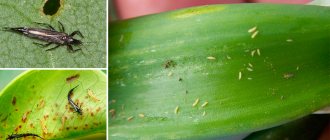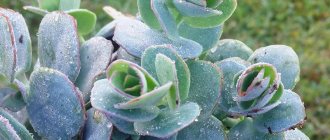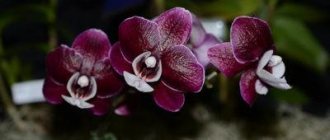The beauty of the daylily flower is that it is beautiful when it blooms. But the culture fades very quickly. Even in the evening you admire the blooming daylilies, and the very next day the buds will wither.
Author of the article
Maxim Sverchkov
Professional biologist and breeder with extensive experience and experience.
They are easy to care for. Regularly loosen the soil, apply fertilizers, and water. And take seriously the choice of place for a flower bed with daylilies.
Description of the plant
The scientific name of these plants, members of the Liliaseae family, is hemerocallis or redwort. The last name reflects the flowering characteristics of daylily.
After all, his life is very short - from evening to the next evening.
Daylilies are perennial plants, herbaceous, summer green. They have grooved leaf plates, linear in two rows.
Daylily leaves may droop in an arched manner or be directed upward. Up to a meter long, short thickened rhizomes in the shape of brushes. In the garden, daylilies can grow up to one and a half meters.
The peduncle can have forty flowers, three or four buds bloom at one time. The flowers resemble stars.
The ancient inhabitants of East Asia began growing daylilies two thousand years ago. The cultivation was carried out by the Chinese and Japanese.
They believe that sorrows leave the soul when the hand touches a daylily bush. Flowers contain lycopene and carotene.
Chinese healers use daylilies for hepatitis, hypertension and heart diseases, and for weakened patients to restore strength. They cook soups with daylily in chicken broth.
This meadow flower became a domestic flower in the 16th century.
In Russia, the name daylily was first mentioned in 1813.
This culture was developed with varying success, and now there are more than 50,000 daylilies.
Most species have been studied by biologists, and daylilies occupy a place of honor in landscape design. Make sure the soil has good drainage. Do not allow water to stagnate in the area with daylilies.
Reproduction methods
Daylilies can reproduce vegetatively or by seeds; the latter is often used by breeders in their work.
In plants grown from seeds, the characteristics are preserved when we are talking about natural species. Vegetative propagation is a guaranteed excellent result; as a rule, everything takes root.
Types of daylily
The best daylilies grow where there is plenty of bright sunlight. The shade has a bad effect on them: the flowers bloom less often or do not bloom at all.
The crop will begin to grow in April. In mid-May, the grass-like daylily will bloom. Then it’s time for the yellow daylily. The latest daylily, red, blooms by July.
Korean daylily
Korean daylily blooms for about three weeks. The grass-like one blooms for almost two months, and it can bloom again in the middle of September.
Depending on the type of daylily, flower stalks can contain about 54 flowers. Korean daylily is distinguished by its miniature flowers, no more than 4 centimeters.
Red daylily
Red daylily has the largest flowers, they reach 13 centimeters in length. The longest peduncle is that of the red daylily, about 90 centimeters, and the shortest is that of the grassy daylily - only 30 centimeters.
The color of daylily in the perianth area ranges from orange to yellow.
Flower growers use the following classification:
- extended flowering - blooms for more than one day, long-flowering;
- diurnal - bloom during daylight hours;
- nocturnal - bloom at night.
The grass-like daylily blooms longer than the others. Having begun to bloom at seven in the morning, it can wither only on the third day.
Yellow daylily flowers can last a long time: after opening at about eight in the morning, they bloom for at least two days.
Korean daylily or Middendorf daylily blooms early in the morning and blooms for no more than a day. Lemon daylily is interesting: it also blooms in the morning and does not fade during the day.
Just listen to these beautiful names:
- pink daylily;
- double daylily;
- black daylily;
- daylily double;
- Stella daylily;
- red daylily;
- daylily siloam.
In 1934, A. Stout published a monograph on daylilies. They discovered the potential of the gene pool of this plant.
Stout described on the pages of the monograph the diversity of all existing daylilies.
In total, there were almost two hundred varieties of daylily. It was called "farmer's daylily" because it was used to plant borders in fields. In America it was of no interest, except for scientific research.
Three years later, a technique for breeding flowers with a larger number of chromosomes appeared. They are called polyploids.
Scientists studied how colchicine affects plant cells. And already in the 50s of the twentieth century, the chemist Fey and Dr. Griesbach developed methods for colchicination of daylily seed material.
During the research, it was established that varieties of red daylily are diploids, but it itself is a triploid and does not form seeds.
Most daylilies are diploids, whose breeding potential has been exhausted. Griesbach interacted with daylily growers and merchants, conducting a number of practical sessions for them.
The mid-1950s were marked by the development of new, tetraploid daylily varieties. Their difference from diploids is that they are more resistant and grow faster. And planting daylilies in the spring is favorable, because they begin to grow earlier.
The number of chromosomes in them is doubled. Tetraploid varieties have more than fifty buds and more flowers. The petals of tetraploids are thicker, rounder and stronger.
At first, the seeds of tetraploid varieties were nonviable and poorly fertile. Breeders managed to obtain new varieties.
Where the climate is warm, such as France and Australia, it will take seven to nine months. Under Russian conditions, seedlings will bloom only after two years.
The main branch of plant growing in America can be considered the hybrid daylily culture. To confirm this, it is enough to study the sales volume and the number of flowers grown.
The American Daylily Society was created to maintain scientific interest in these flowers and register new clones.
This is easy to do, which is why there are varieties that are of no value. There are also original ones that are not registered, such as those bred by the French breeder Pierre Enfosso.
Commercial replication of popular varieties by the microclonal method was unsuccessful. This is due to the fact that daylily clones bear little resemblance to their parents. The flower stalks are deformed, the fringe of the petals disappears, and the color becomes less bright.
A number of semi-evergreen and evergreen daylilies are considered insufficiently winter-hardy; they are not adapted to Russian wintering, to successful development and growth.
But in different regions of our country there are differences in natural and climatic conditions, and the introduction of new varieties is carried out depending on the specific location.
Over three thousand varieties of daylily have been tested in the Russian Federation. The main sign of the successful development of floriculture is the activity of flower growers around the world in the field of selection.
Caring for daylilies in the garden
Daylilies are very beautiful, and at the same time they do not require any special care. For example, they do not need frequent watering. It is recommended to carry out this procedure only during a long drought, and a large amount of water must be poured under each bush so that the soil is well saturated with it. Daylilies should be watered in the evening. The number of fertilizing directly depends on whether the soil is nutritious or not; in this regard, the gardener must independently calculate how many times he will have to apply fertilizer, but remember that such flowers cannot be overfed. However, it should be borne in mind that 2 feedings are required. The first time you need to feed the flowers is in the spring after the leaves begin to grow; for this, mineral fertilizer is used. Dry granules must be distributed over the surface of the site, and then embedded in the soil using a rake, then the soil must be watered. The second time it is necessary to feed the plant in August, 4 weeks after the peak of flowering. This will help make future flowering more magnificent, since it is at this time that the buds are laid. Experienced gardeners recommend using Kemira-plus for fertilizing. The main thing to remember is that fertilized soil must be watered.
Mulching the area is also very important for daylilies. This will help avoid soil compaction above the root collar. The central part of the bush should be covered with a three-centimeter layer of mulch, using coarse river sand. If the soil is poor, it is recommended to use compost or peat as mulch, which is sprinkled between the rows, and for nutritious soil it is better to choose tree bark or pine needles. Mulch the soil in order to protect the plant from sudden changes in temperature, to preserve moisture and to reduce the amount of weeding. The thickness of the mulch layer should be about 6–7 centimeters. If the soil is not mulched, you will have to regularly loosen its surface and remove weeds. Also, do not forget to promptly pick off flowers that have begun to fade.
Daylily propagation
In August, during transplantation, do not forget to divide the bushes. This method of reproduction is described in more detail above. Seeds can also be used for propagation, but such plants are not able to retain their parental characteristics. In this regard, daylilies are grown from seeds mainly by breeders. Daylily can also be propagated in another way, without having to dig up the main bush. However, this method is only suitable for plants with loose bushes. After the bush is 3 or 4 years old, it will be possible to separate the daughter rosette with a fully formed root system. To do this, take a very sharp shovel and place it in the place of the future cut, positioning it strictly vertically. Then sharply press the shovel with your foot, which will allow you to cut off the necessary part, which must also be cut from below and pulled out of the soil. Places of cuts and damage will need to be sprinkled with crushed coal or wood ash. Daylily can be propagated in this way in the spring (when the leaves are just starting to grow) or in the fall (when the leaves are cut off).
Reproduction of daylilies.
Diseases and pests
Such plants are quite resistant to various diseases and harmful insects, but still sometimes problems arise with them. Of the harmful insects, the greatest danger to daylilies are lily mosquitoes, slugs, daylily thrips and water voles.
Thrips
Thrips are able to penetrate the daylily from the soil at a temperature of about 10–12 degrees. They feed on plant sap, sucking it out of flowers, leaf blades and stems, while deformation of the flowers occurs already in the buds. If you see that the plant is affected by such pests, the bush should be destroyed after digging it up. Take preventive measures. To do this, you need to spray the soil around the flowers with insecticides in spring and autumn, while making sure that there are no plant debris in the area that could contain pests.
Lily mosquito . These insects lay larvae in buds. The grown larvae feed on the flowers, causing their deformation. To get rid of such pests, you just need to pick all the affected flowers and destroy them.
Water voles . They prefer to eat not only daylily roots. The problem is that once every 3 or 4 years there is a sharp increase in the number of these rodents, and at this time they eat the bulbs of tulips and lilies, as well as the roots of young apple trees and daylilies. It is impossible to destroy such pests, but they must be dealt with using suitable methods.
Slugs
Slugs . They can be removed from the plant manually or treated with Thunderstorm.
Of the diseases, daylily is most susceptible to rust, fusarium and root rot.
Root rot . It most often appears in spring. The growth of young foliage on the affected bush stops, it becomes yellow and is easily pulled out of the soil. Dig up the diseased bush and remove all rotten areas, and then wash it in a pink potassium manganese solution. The wounds need to be treated with a fungicide. The root system must dry well, and this will take 2 days. Then the bush must be planted in another place. Such a plant will not bloom for a couple of years. Where the affected bush grew, it is not recommended to plant daylilies for at least 12 months.
Rust
Rust . This disease occurs only in those daylilies that are grown in close proximity to the patrinia. For preventive purposes, apply abundant fungicide treatment.
Fusarium . Infected bushes look stunted, their leaves quickly turn yellow and wither, and the roots look more like rot. This disease is fungal and can be treated initially with a fungicide. A severely affected bush must be destroyed, and the soil where it was grown, as well as plants located in the neighborhood, must be treated with foundationazole. Prevention:
- sterilization of garden tools;
- adding Fitosporin-M to water for irrigation;
- loosening the soil surface after watering.
DAILYLINK - cultivation, care, diseases
About species and varietal daylilies
Species daylilies are very popular among Russian flower growers. Varietals go through selection. It takes a lot of time. They are unpretentious and resistant to cold. Unless the arid south does not suit them.
Winter-hardy varieties are used in design.
Daylilies were first described by Pliny in his treatise Natural History. Then, in the 70s AD, Dioscorides said that the flowers and leaves of yellow daylily have medicinal properties.
And in the 15th century, “Herbalists” began to be produced in Europe, where famous varieties were also described.
Daylily yellow
Belongs to Asian varieties. In Russia, he loves the slopes and outskirts of forests, the banks. Blooms in early summer. Up to a meter high.
The flowers are fragrant, lemon-colored, the inflorescence contains about ten pieces. The foliage is wide, bright, attractive.
Daylily brown-yellow
The origin of this daylily could not be established, but the geography of its growth is extensive. Its dried flowers are called golden needles.
Each new flower grows in the fold of the old one in the opposite direction. It is soft underneath, although hard on top. Peduncles are bare and longer than the foliage.
The number of yellow-orange flowers, similar to lilies, can reach 20. Their inner part is red, the perianth lobes have wavy edges.
Of interest are the semi-double and terry forms. Ordinary flowers become double over time.
Daylilies are suitable for any conditions. When snow falls, he is not afraid of even forty-degree frost.
Small daylily
In Russia, Siberia is close to this daylily. Graceful daylily bushes are low, not much more than half a meter in height.
Narrow leaves touch the ground. There are up to five flowers in an inflorescence; they appear at the end of spring, and in June they already bloom profusely.
Daylily Middendorf
Daylilies do not grow only in Kamchatka. Slopes, deciduous forests, and cliffs suit them. The foliage is drooping and narrow.
Near the base of the fresh leaf blades you can see the remaining leaves from last year. Fragrant orange flowers in tall peduncles.
Daylilies bloom in May and throughout the fall. Seed ripening occurs in July.
Modern varieties are tetraploids. After the first flowering cycle, they undergo a second. The main thing is that the summer is warm and long. It is a mistaken belief that only tetraploids are charming.
Diploid varieties are just as beautiful, with large flowers with serrated petals. You can see watermarks, colored borders, and flounces on them.
If the summer is cool and there is little sun, the perianth will not be able to open. However, the bright sun can also destroy flowers.
This is possible with some varieties, so for them you need to choose partial shade.
Remember that it is better to buy seeds from people you know. If you come to the exhibition for seed material, also choose proven ones. It is even more risky to buy from someone else.
Even if you are interested in modern varieties, do not give up old, well-proven ones. Among them there are interesting samples. One of them has yellow flowers and a lilac underside, the other has orange...
The store may sell re-sorted items. Although if you do buy seeds there, do the following. When you get home, plant the division in a shallow container so that all the roots fit. The soil should be slightly damp.
Then cover the container with a plastic bag with several holes and place it in the refrigerator. Ventilate it every week, moisten it and check for mold formation.
If necessary, buy Fitosporin M for spraying. When April arrives, place the container on the windowsill and water as needed. And in May, harden off and plant.
In another article we described a flower called Heliopsis.
Planting daylilies in open ground
What time to plant
Such flowers are planted in spring, summer and autumn; the exact time of planting directly depends on the climate in your region. If winter comes quickly and very early in the region, then daylilies planted in autumn may not have time to adapt to new conditions before frost, because it takes about 4 weeks for them to take root. However, if garden forms with a medium or early flowering period were chosen for planting, then in mid-latitudes they will be able to quickly take root and prepare for winter. You can also protect plants from freezing by sprinkling the area with a layer of mulch.
Experienced gardeners recommend planting daylilies in open ground in the middle zone in May or August. Dividing or transplanting also needs to be done in the spring or at the end of summer.
How to plant
Before you begin planting store-bought planting material, it must be immersed in water or mineral fertilizer, which must be highly diluted, for several hours. This will cause the roots to become swollen and lively, in which case you can easily select unhealthy roots and carefully remove them. The remaining roots must be shortened to a length of 20 to 30 centimeters.
For each bush or division, you should prepare a separate planting hole, the depth of which should be about 0.3 m. Also remember that this flower will grow in one place for quite a long time, and during this time it will grow in diameter to 0.5–0. 7 m, so try to leave such a distance between the bushes so that they are not crowded. A soil mixture consisting of peat, sand and humus should be poured into each of the prepared holes, then add phosphorus-potassium fertilizer or wood ash mixed with superphosphate. Then you need to place the plant’s root system in the hole and carefully straighten it, while making sure that there is no empty space left under it. After this, fill the hole with soil, but not to the top. Then, holding the bush with your hand, compact the soil thoroughly and pour enough water into the hole so that it is full. If the liquid is quickly absorbed into the soil, this means that the earth is poorly compacted, so pour dry soil into the hole and compact it thoroughly again. Then you need to fill the hole to the brim with soil. When planting, make sure that the root neck of the flower is not buried more than 20-30 mm into the ground, otherwise growth retardation and rot may occur. If you planted a daylily, following all the rules, then there should be enough water in the holes for the bush to take root completely.
Transfer
You can grow such a flower in the same place for about 15 years, but over time the quality of flowering will deteriorate. If you see that your previously luxurious and already middle-aged bush has become less spectacular (the flowers have been crushed and there are fewer of them on the peduncle), then this means that it is time for a replant. First, dig up the bush along its outer border and carefully remove it along with the earthen lump, while trying not to injure the roots. The root system needs to be washed out with a garden hose, and then it can be carefully divided into separate fans. If you have certain skills, then you can divide the bush with your hands, but if you use a knife or pruning shears, then the cut areas must be treated with a fungicide. It is recommended to plant and replant on a cloudy day, but if you have to wait long enough for suitable weather, it is recommended to bury the bushes or cuttings in the sand, where they can stay for about half a month. Before planting a specimen, you need to shorten the roots, and also cut off all dead and rotten ones. Then trim the leaves to a height of 15–20 centimeters in an inverted “V” shape. Plant the prepared division in a permanent place.
Growing a plant
Daylilies are considered long-lived. They live without replanting for up to ten years in one place. Flowers are very unpretentious. Both partial shade and sunny side suit them.
The soil should be close to neutral, but the flower will grow on slightly acidic soil. It is better to fertilize it, but even without feeding, daylilies will be able to develop normally.
And they are not afraid of drought, although in the heat, do not forget about watering. Weeds overwhelm the plants in the first couple of years.
Then the spreading daylilies simply do not allow them to exist in peace. Harmful insects and diseases also avoid them.
Daylilies have a compact rhizome with short but powerful branches. Penetrating deep into the ground, the roots form stolons there.
The leaf plates forming the basal rosette are curved and long. Above them grow peduncles, strong and straight, the buds on which open gradually.
They don't need a garter. Daylily flowers resemble lilies, but their shapes are more interesting. Their palette is varied.
Particularly beautiful are those with rings or stripes of a different color. There are also varieties whose leaves are white-green. Daylily has very beautiful leaves.
It is planted next to plants that do not have a beautiful lower part, in front of tall flowers.
Earlier we talked about Astilboides.
Variety of varieties
There are over 30 thousand varieties of daylily, each of them has its own characteristics; the real decoration of a summer cottage are the terry varieties, characterized by lush flowering.
Decorative daylilies have basal leaves that look very beautiful together, reminiscent of an oriental fan. In some species, longitudinal stripes of white or yellow flowers are visible on the leaves.
Plant hybrids are also worthy of the attention of amateur gardeners; thanks to daylily, your garden will become more beautiful.
Classification of daylilies
Daylilies are distinguished by flower size:
- miniature (no higher than 7 cm);
- medium-flowered (not higher than 12 cm);
- large-flowered (not higher than 17 cm).
Depending on the height of the peduncles, daylilies are divided into:
- dwarf. Since their height is small, almost 30 cm, they are suitable for the formation of rocky hills and rockeries.
- short. Already a little taller, reaching half a meter, suitable for borders. Popular are “Mini Stella”, “Little Greta”, “Vini”.
- average. Up to 80 cm. They frame ponds and are planted in the form of separate clumps and in groups. tall. Up to a meter, they look great individually along the perimeter of the entire site. Popular among
- flower growers varieties: “Abstract Art”, “Barbara Host”, “Bourbon King”, “Varzity”, “Gusto”, “Zats Fan”, “Strawberry Candy”, “Little Darling”, “Night Bacon”, “Olweis Afternoon” , “Regal Air”, “Red Sea”, “Terkin”, “Black Magician”, “Black Prince”.
There is a classification of daylilies according to the degree of winter hardiness:
- dormant, they are also called deciduous. The most winter-hardy, can grow in many Russian regions. The foliage of these daylilies falls off immediately with the onset of autumn cold, and buds are formed at the same time.
- evergreen. They will be destroyed by wintering in Russia. The foliage persists until frost strikes, and then withers. With the onset of thaws, evergreen daylilies form winter. Some types of such flowers do not tolerate frozen soil. There are known varieties of daylily that do not fade for a day
Flowering period and after care
Daylily throws out flower stalks, each of which contains 10-30 buds. Every flower blooms in the morning and fades in the evening. At the same time, 2-3 flowers bloom on one peduncle. The flowering period lasts 30-45 days. Early varieties begin to bloom in June, late varieties - in August-September. By selecting a collection of varieties, you can achieve flowering of daylilies in your dacha from early summer to late autumn.
Perennial flowering
Interesting information! There are nocturnal varieties of daylilies, the flowers of which bloom in the evening and fade by morning.
Many gardeners are interested in how to properly care for blooming daylilies. In order for the plant to maintain its decorative appearance, faded flowers must be regularly plucked out. This stimulates new buds to bloom. An unkempt plant with wilted petals looks sloppy.
Planting a plant
Daylilies are decorative flowers. They are spectacular in a mixborder next to a pond; they can be planted in groups or individually. Dwarf varieties are suitable for rose gardens.
Thanks to their beautiful foliage, daylilies look beautiful with any roses. Most daylily varieties bloom when roses have finished their initial wave of flowering.
If they are low, the same low varieties of daylilies are combined with them. Try to combine with large flowers, since daylilies are quite powerful. Maintain a small distance between them.
Planting is carried out in the spring, when the above-ground part reaches 15 centimeters. It is possible to plant daylilies when flowering ends, or during the growing season.
Prepare the flower itself. Shorten the roots of the daylily by 1/3, keep them in a saturated solution of manganese, sprinkle with a root former, for example, “Kornevin”.
Choose a suitable place on the site, dig a hole. Mix the dug soil, sand, compost, peat in equal proportions, pour 200 g of ash on top, water it and place it in the hole.
Make a mound in the middle and place the plant, carefully straightening out all the roots. Cover with sand. Water thoroughly. Mulch the ground under the daylily.
Propagation using seeds
Daylilies grown from seeds, as a rule, lose the characteristics of the variety; plant breeders propagate the plants with seeds, and for the garden it is better to purchase seedlings. Having decided to experiment with growing flowers from seeds, you need to know all the features of this process.
The seeds of the plant are soaked in water diluted with hydrogen peroxide, 15 ml of a three percent peroxide solution per 1 liter of water. Cover the seeds in the container with plastic wrap and leave in a dark place.
It takes 4 to 14 days for the seeds to germinate, so look under the plastic every day and check whether the seeds have sprouted or not.
As soon as you see white roots, drain the water, pour fine gravel into another container and distribute it evenly along the bottom. Place the seeds on top, it is necessary that the roots are in the water and the seeds are above its surface. It is recommended to add the drug Epin to the liquid; one drop is enough per glass of water.
Place the seeds in the container in the light, while the water level should be maintained at the same level. You can simply inject liquid from a spray bottle when necessary.
Thanks to illumination, daylilies can be grown starting in October; when this is not possible, the seeds should be soaked in March.
This method also has its disadvantages: sometimes a completely different variety appears in the flower bed than is depicted on the bag of seeds. However, any daylily looks beautiful and gives others positive emotions.
Features of care
Remember the main thing: complete fertilization of the land, plenty of water and natural light are important. With the arrival of spring warmth, fertilize the soil using potassium and nitrogen.
To do this, dissolve a tablespoon of potassium and the same amount of nitrogen in 10 liters of water. Expect to use half a liter of solution for each flower.
When flower stalks appear, phosphorus feeding will be needed. To do this, loosen a tablespoon of the substance under each bush.
If the daylily has faded, take a tablespoon of potassium and the same amount of phosphorus and dissolve it in 10 liters of water.
In subsequent years, either in the spring, sprinkle ash (half a glass is enough), and in the fall - rotted manure in a small amount or "Gumi" or "Fitosporin".
Additionally, daylilies do not need to be fed. Try “AVA” fertilizer - one teaspoon is enough for the soil every three years.
Remove buds and flower stalks that have already completely faded. This way you will help the daylily maintain its decorative properties.
How to make proliferation
The term “proliferation” should be understood as “rooting of inflorescences,” a method that allows you to grow daylilies that have the characteristics of the variety.
It is important that the leaf rosettes (proliferations) develop well, so the peduncle is left on the plant until its upper part dries out completely. After this, the peduncle is cut off and the leaves are shortened by one third, and the rosette is placed in water so that the roots develop.
A growth stimulator will help speed up the process; add 1-2 drops of Zircon and Epin to the container. In the photos of daylilies presented in our gallery you can see a variety of varieties that allow you to create unique landscapes.
Daylily: combination with other plants
Despite their grandeur and variety of colors, daylilies fit harmoniously into almost all color compositions; the main thing is to choose plants for them that will ideally match their color, shape or texture.
The mono-composition will be brighter and richer if daylilies of pastel shades are combined with plain gravilates, and bright lilac or crimson with geraniums, monardas, bells and cuffs.
Daylily in a flowerbed
Daylilies are also great for Thunberg barberry, heuchera and tenacious, as well as shrubs - elderberry, mock orange, privet, if they are evenly distributed over the mixborder.
The ideal neighbors of daylilies are phlox, since they bloom almost simultaneously, and even combine perfectly with each other in color. For example, lilac phlox will complement lavender daylilies.
The main reasons why daylily does not bloom and what to do about it
There are several reasons why daylilies do not bloom well, but the green tops look healthy and strong. The main task of the gardener in this case is to determine the factor that negatively affects the formation of peduncles.
Lack of sun or moisture
Despite the fact that daylily is an amazing plant that tolerates all conditions. It develops well on the site in places where other crops refuse to grow. However, if the daylily does not bloom, then the reason is the significant darkness of the flowerbed. For full growth and perfect flowering, the bush needs diffused, abundant light for at least 6 hours. An area with direct sunlight also adversely affects the development of the crop, as it causes leaf burns.
Lack of moisture affects flowering. You can determine that it is time to water the bush by the condition of the leaves: drooping tops signal the need for the procedure. During the dry period, the plant is watered once every 7-10 days in the evening.
Close proximity to large bushes and trees is considered an unfavorable factor for the plant. In such a neighborhood, the plant will lack light, water and nutrition. If the daylily does not bloom due to the density of the plantings, the bush should be replanted. After all, culture prefers freedom for development.
Closeness
Some varieties of daylilies grow very quickly, proportionally increasing their green tops and roots. After just a few years, the division turns into a massive bush, which will require a significant amount of nutritional components. It is advisable to divide the rhizome once every 5-6 years. The procedure will help rejuvenate the culture, get rid of thickening and replenish nutrition.
Failure to comply with planting deadlines
Despite the fact that daylilies can be replanted from spring to autumn, summer planting of seedlings very often leads to no flowering. Unfavorable weather factors lead to the plant’s refusal to lay future flower buds. Bushes transplanted in summer, as a rule, bloom after 2 years.
Autumn planting also negatively affects the plant and future flowering. If planting is done too late and the bush does not have time to take root before frost, then in the spring it is frail and painful. Fungi and rot develop on such plants. Restoring damaged roots may take 2-3 years, during which there will be no flower stalks.
Important! Autumn planting is carried out in October 1.5 months before the onset of frost.
Acclimatization of daylilies
Modern varieties have been bred by breeders with high characteristics. Despite this, daylilies require a period of acclimatization, especially in cold regions of the country. That is why, in the first 2 years, young seedlings are covered for the winter, and in the fall the soil surface is mulched with peat, sawdust, and dry leaves. In addition, sharp fluctuations in temperature indicators lead to the fact that the bush cannot adapt to the conditions of detention. Due to such factors, the plant weakens and refuses to bloom. When planting a new variety, the gardener should be patient and wait 1-2 years. If the bush does not bloom, start taking action.
Recessed landing
Planting the rhizome too deeply is a common reason why daylilies do not bloom well. Naturally, it is necessary to deepen the root system, but the distance from the soil surface must be at least 2 cm.
A deeply planted plant refuses to bloom for many years. If the bush is not helped, flowering will occur only when the crop does not move to the surface on its own and the soil is not washed away by rain.
How to care for redwood?
This aspect deserves special attention. After planting flowers in open ground, they need to be watered generously. As for the content, there are no strict rules that must be followed.
Experienced gardeners who have been breeding daylilies for a long time are advised to adhere to the following recommendations:
- During the first week after planting, plants need daily watering. Adult flowers do not require much moisture, so the soil is moistened as needed. Watering becomes more frequent during hot months when there is a long absence of rain. To do this, use warm water, since the root system is afraid of low temperatures.
- During the active growing season, faded buds should be trimmed. This will prolong flowering, so the crop will delight you with its attractive appearance much longer.
- When planting rednecks, the rhizome must be deepened into the ground by 2 centimeters. If the roots are placed too deep, they may not bloom, resulting in them having to be replanted.
- After each watering, you need to lightly fluff up the soil to provide the tuber with fresh air.
The tips listed above will make growing daylilies in open ground as simple as possible. At the same time, they are universal, so you can use them regardless of what varieties you are breeding.
Diseases and pests
Daylilies are lucky, they are in good health, resistant to disease and are rarely affected by pests.
Of the diseases, the main danger for daylilies is root rot . Its causative agents can be bacteria or fungi, and the cause is waterlogging of the soil.
Signs of the disease are slow growth and yellowing of leaves. They become flaccid, sticky, and easily come off the base. Urgent measures are taken immediately at the first symptoms of the disease. The plant is completely dug up. The roots are washed in a solution of potassium permanganate, all affected parts are cut out with a sharp knife, and then the sections are sprinkled with fungicide.
, the daylily mosquito causes problems . It reproduces by laying eggs in flower buds. Damaged buds do not grow and become deformed. They are cut off and destroyed.
Cutworm caterpillars hibernating in the soil in early spring can damage and destroy young shoots and plant buds. Pests are destroyed by weeding the rows and treating daylilies with insecticides. The use of poisoned baits is also effective.
In any garden you can find a small corner for daylilies. This is a grateful plant. With minimal care, it will delight its owners with beautiful flowering. Daylilies are good not only in flower beds, in borders or on alpine hills, but when cut, they look no less festive and luxurious in bouquets!
You can learn the advice of experienced gardeners on growing daylilies by watching the video.
Choosing a landing site
It is believed that daylilies can grow anywhere, because in their homeland, the Far East, they thrive in shady forest corners.
But in the temperate climate of central Russia, daylilies in partial shade will not have enough warmth for luxurious flowering, and such planting will not allow the plants to show all their potential. It is better for them to choose sunny areas protected from the wind.
It is advisable that the plants are fully illuminated for at least 5–6 hours a day. Daylilies with delicately colored flowers need light throughout the day, while varieties with rich and dark colors require midday shading to prevent fading in the heat.
You can learn more about the characteristics and features of daylily varieties from the article “Popular daylily varieties.”
The soil for daylilies should be neutral or slightly acidic. The soil for plants is prepared in advance and carefully, because daylilies will have to grow in a permanent place for a long time - 6-15 years.
The soil is dug to a depth of 30–35 cm. Compost, peat, sand are added to heavy clay soil so that the moisture does not stagnate. Sandy soils, on the contrary, are light and do not retain water and nutrients well, so they are enriched with humus and clay is added.
When groundwater is close, daylilies are planted on ridges 10–15 cm high.
How to make daylilies bloom after transplanting?
First, let's get acquainted with the features of transplanting daylilies at different times of the year.
- In the spring. Krasodnev will release flower stalks this same summer, but they will not be full-fledged.
- In summer. Not the best time for a transplant. Heat promotes the activation of bacterial infections and fungal diseases. If you do carry out this procedure, shade the plant and provide it with abundant and regular watering. If possible, replant daylilies early in the season.
- In autumn. But this time is optimal for the transplant procedure. It is best to do this 1.5 months before the first frost (focus on the climate of your region). At the end of flowering, you should dig up the plant, inspect its rhizome, remove places where there is damage, and plant it in prepared soil. This way, your daylily will have time to take root before the first frost hits, and will be able to comfortably overwinter.
In order for the daylily to bloom after transplantation, you must:
- transplant it to a place where there will be no lack of insolation;
- leave the root collar on top of the soil;
- feed the plant during the formation of buds with fertilizers containing potassium and phosphorus;
- if the transplant was carried out in the autumn, then closer to winter, add organic matter to the soil, slightly hilling the roots;
- If in the spring you notice old leaves on your daylily, cut them off so that they do not interfere with the growth and development of new ones.











